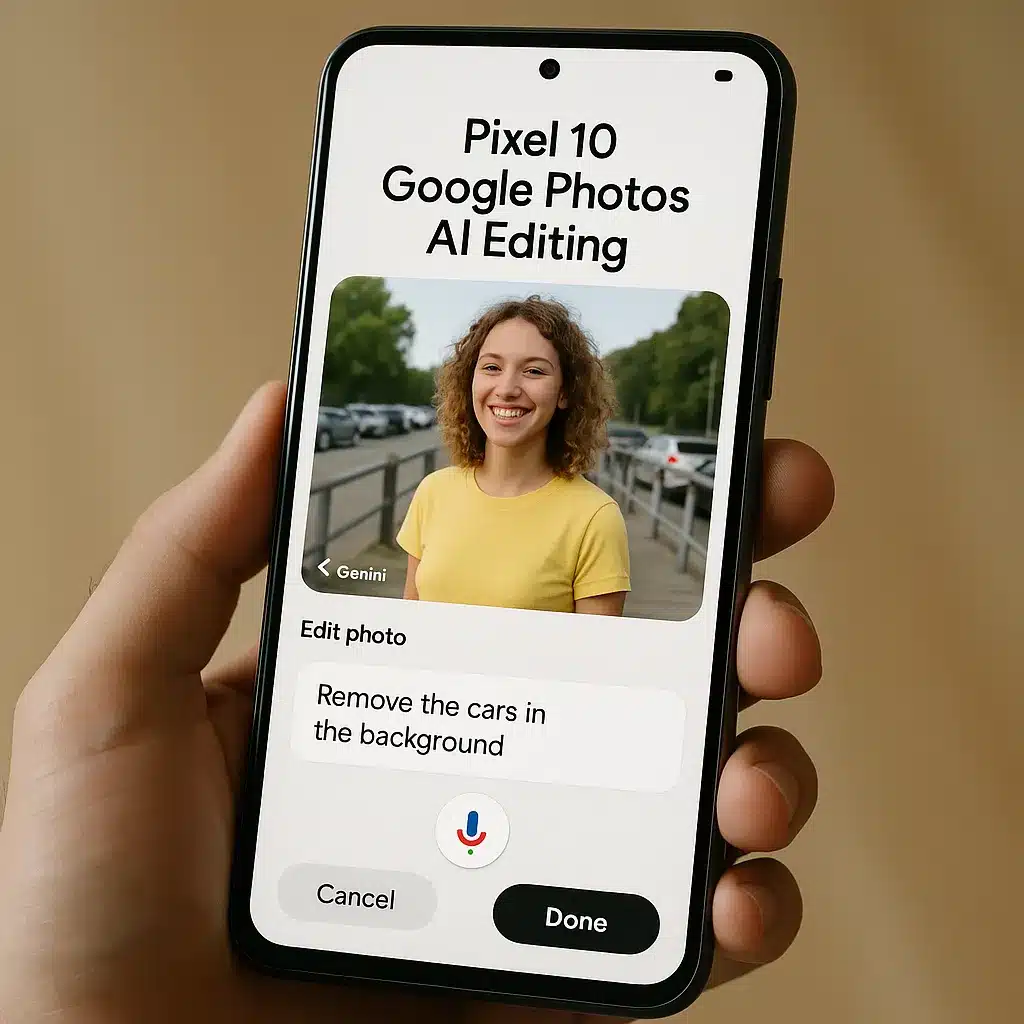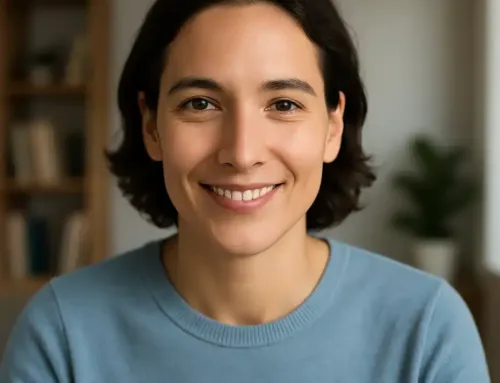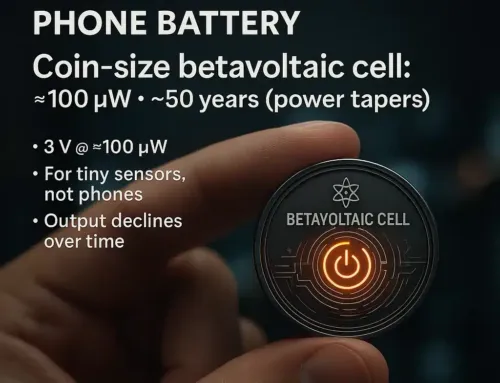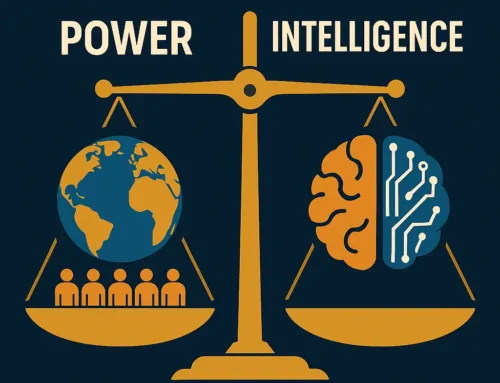
Approx. read time: 8.8 min.
Post: Pixel 10 Google Photos AI Editing Magic
Google Photos AI editing
Introduction: A New Era of Photo Editing
For decades, photo editing has been a skill that required time, patience, and sometimes expensive software. From Adobe Photoshop to mobile editing apps, the tools have grown more powerful—but also more complicated for casual users. Google has long attempted to bridge that gap with features like Magic Eraser and Photo Unblur. But at the Made by Google 2025 event, the company took its boldest step yet: introducing Ask Photos, a conversational photo editing tool inside Google Photos that lets anyone transform their images using natural language.
Debuting on the Pixel 10 lineup in the U.S., Ask Photos allows you to simply tell your phone what you want changed. Whether by voice or text, users can ask for edits like:
-
“Remove the people in the background.”
-
“Make this look like a vintage film photo.”
-
“Brighten the face.”
-
“Add sunglasses and a hat.”
-
Or even: “Make it better.”
Behind the scenes, Google’s Gemini AI interprets these prompts, applies edits, and even suggests further improvements. Combined with the C2PA content credentials standard, which adds transparency about how images were created and modified, Ask Photos marks a significant evolution—not just for Google Photos, but for the future of AI-powered creativity.
This post takes a deep dive into Ask Photos, its underlying technology, its impact on photography and creativity, and what it means for digital trust.
Part 1: What Is Ask Photos? – Google Photos AI editing
At its core, Ask Photos is a natural-language interface for editing images. Instead of navigating menus, sliders, or learning technical jargon like “contrast curves” or “Gaussian blur,” users can simply describe the result they want.
Examples of Prompts Users Can Try
-
Practical Edits:
-
“Remove the red-eye effect.”
-
“Sharpen the photo.”
-
“Crop this to a square.”
-
“Adjust lighting to make it brighter.”
-
-
Restoration Tasks:
-
“Restore this old family photo.”
-
“Fix scratches and fading.”
-
“Make it look newer.”
-
-
Creative Play:
-
“Add fireworks in the background.”
-
“Turn the sky purple.”
-
“Give me a cartoon version.”
-
-
Vague Instructions:
-
“Make it look better.”
-
“Improve this for social media.”
-
In each case, Gemini interprets the intent and generates edits, often suggesting alternatives along the way. This allows both novice users and professionals to quickly experiment and refine their photos.
Why This Matters – Google Photos AI editing
The breakthrough is accessibility. While apps like Photoshop or Lightroom are beloved by pros, they remain intimidating to average users. Ask Photos removes the friction. Editing becomes as simple as having a conversation with your phone.
Part 2: The Technology Behind Ask Photos
Ask Photos is powered by a blend of on-device AI processing and cloud support:
-
Gemini AI Integration
-
Google’s Gemini models are designed to understand natural language deeply, including context and nuance.
-
When a user says, “Remove the cars in the background,” Gemini parses the image, identifies objects labeled as cars, and applies Google’s generative fill and inpainting models to remove them seamlessly.
-
-
Tensor G5 Chip
-
The Pixel 10 series debuts Google’s Tensor G5 processor, designed for heavy AI workloads.
-
It enables faster, more private, on-device editing without always needing cloud processing.
-
-
Contextual Suggestions
-
Ask Photos doesn’t just wait for commands; it proactively suggests improvements like “Do you want to brighten this photo?” or “Should I crop this to highlight the subject?”
-
-
Iterative Editing
-
Users can build on edits. For example:
-
Step 1: “Remove the people in the background.”
-
Step 2: “Brighten the foreground.”
-
Step 3: “Add a sunset effect.”
-
-
This iterative refinement mimics working with a designer, but powered by AI.
Part 3: The Role of C2PA Content Credentials
A major concern in today’s digital landscape is authenticity. AI can manipulate photos so convincingly that it’s increasingly hard to tell what’s real. Google’s solution: C2PA Content Credentials.
What Is C2PA?
-
The Coalition for Content Provenance and Authenticity (C2PA) is an open standard that embeds metadata into images and videos.
-
These credentials show:
-
How and when the image was created.
-
What edits were made.
-
Whether AI was involved in generating or altering the photo.
-
Google’s Implementation
-
Pixel 10 devices are the first Google phones to adopt this system.
-
Even if AI is not used, every photo taken with the Pixel Camera app includes content provenance metadata.
-
This means any edited photo can carry a transparent history of how it came to be.
Why It Matters – Google Photos AI editing
-
Trust & Transparency: Users (and platforms) can verify if an image is authentic or AI-manipulated.
-
Combatting Disinformation: In an era of deepfakes and manipulated media, this helps maintain trust in digital imagery.
-
Industry Leadership: Adobe, Microsoft, and other companies have joined the C2PA initiative. Google’s adoption pushes the ecosystem forward.
Part 4: Real-World Use Cases
Everyday Photography
-
Parents can quickly fix lighting on a photo of their kids.
-
Travelers can remove unwanted crowds from landmark shots.
-
Social media users can stylize their selfies with filters or props—no design knowledge required.
Professional Applications
-
Small business owners can produce polished marketing images without hiring designers.
-
Real estate agents can enhance property photos while retaining C2PA transparency.
-
Journalists can maintain credibility by embedding verifiable content credentials.
Accessibility & Inclusivity
For users with limited technical knowledge—or physical limitations that make detailed editing difficult—Ask Photos represents a new level of digital accessibility.
Part 5: Pixel 10 Hardware & AI Ecosystem
The Pixel 10 family includes:
-
Pixel 10
-
Pixel 10 Pro
-
Pixel 10 Pro XL
-
Pixel 10 Fold
Each runs on the Tensor G5 chip and includes hardware tuned for AI performance.
Other AI Features on Pixel 10
-
Magic Cue: Context-aware suggestions for writing or communication.
-
Gemini Live: Conversational AI assistant with multimodal capabilities.
-
Camera Coach: Provides real-time photography tips while shooting.
-
Pixel Journal: Automatically curates a visual diary with photos, notes, and AI-generated summaries.
Ask Photos is just one piece of this broader AI-first ecosystem Google is building.
Part 6: Competitors and the Market Context – Google Photos AI editing
Google isn’t alone in AI-powered editing:
-
Adobe Firefly: Generative AI for Photoshop and Illustrator.
-
Canva Magic Studio: Conversational design tools.
-
Apple Photos (iOS 18): New AI editing but less advanced conversational integration.
-
Samsung Galaxy AI: Object removal and generative fills.
What makes Ask Photos stand out is its deep integration with natural language and its hardware-backed transparency features.
Part 7: Ethical Questions and Considerations
While Ask Photos is powerful, it raises questions:
-
Manipulation vs. Enhancement: Where’s the line between creative expression and misleading imagery?
-
Over Reliance on AI: Could users lose basic photo-editing skills?
-
Privacy Concerns: While edits are processed on-device, users must trust Google’s handling of AI interactions.
-
Cultural Impact: As AI makes “perfect” images easy, will authenticity in photography be diminished?
Google’s adoption of C2PA credentials is a step toward addressing these concerns, but broader debates remain.
Part 8: Availability and Rollout
-
Launch Date: Ask Photos is available starting August 20, 2025.
-
Exclusivity: First on Pixel 10 series in the U.S.
-
Expansion: Gradual rollout to Google Photos on Android and iOS globally in the coming weeks.
This staggered release allows Google to refine the tool and scale responsibly.
Part 9: The Future of AI in Photography – Google Photos AI editing
Ask Photos hints at where the industry is heading:
-
Seamless Conversational Creativity: Editing, enhancing, and generating media through voice and text.
-
Ubiquitous AI Editing: Soon, any photo app could support natural language requests.
-
Transparency Standards: C2PA may become a baseline requirement for trustworthy digital media.
-
AI as a Co-Creator: Instead of replacing human creativity, AI will become a partner—helping users translate ideas into visuals faster.
Conclusion – Google Photos AI editing
Ask Photos represents the next chapter in accessible, trustworthy, AI-driven creativity. By combining Gemini AI’s natural language understanding with Pixel 10’s Tensor G5 chip and C2PA transparency standards, Google is redefining what it means to edit photos in 2025.
No longer confined to experts or specialized apps, photo editing is becoming a conversational experience anyone can use. For Google, this isn’t just about smarter editing—it’s about democratizing creativity while keeping authenticity intact.
As Ask Photos rolls out globally, it may not only change how we edit our snapshots—it could also reshape how we trust and share digital imagery.
Google Photos AI editing
The arrival of Ask Photos on Pixel 10 is more than just another upgrade—it represents a turning point in how we approach AI photo editing. For years, powerful editing tools were locked behind steep learning curves or expensive software. Now, with Gemini-powered natural language photo editing, anyone can enhance, restore, or creatively transform their pictures simply by asking.
Equally important is Google’s commitment to C2PA content credentials, which ensures transparency at a time when AI-manipulated imagery is both widespread and controversial. By embedding provenance data directly into photos, Google is setting a precedent for accountability that the broader tech industry will likely follow. This dual approach—empowering creativity while preserving authenticity—is a balancing act that could reshape digital media in the coming decade.
For creators, small businesses, journalists, and everyday users, this combination of Google Photos AI editing and verifiable content credentials delivers the best of both worlds: effortless creativity and trustworthy outputs. Whether you’re fixing a family snapshot, producing marketing visuals, or simply experimenting with fun edits, the Pixel 10 makes professional-quality results accessible to everyone.
In the end, Ask Photos is not just a feature—it’s a vision of the future of photography: one where AI is not a replacement for human imagination, but a partner in bringing it to life. As the rollout expands beyond Pixel 10 to Android and iOS devices, the world is about to experience a new era of conversational, transparent, AI-assisted image editing.
References – Google Photos AI editing
-
Tom’s Guide – Simply ask Google Photos to edit your images
-
Tom’s Guide – Hands-on: Ask Photos on the Pixel 10 Pro
-
Android Central – All the biggest announcements at Google’s Pixel event
-
Google Blog – Pixel 10 AI features and updates
-
PetaPixel – Pixel 10 series hands-on: What’s new for photographers
Related Videos:
Related Posts:
Experience the Amazing Virii8 Virtual World on NationStates
Your PC’s a Mess. Here’s the 10-Minute Windows Cleanup Anyone Can Do
Samsung Galaxy Z Fold6 Review: Why It Beats Apple and Redefines the Smartphone in 2025
Bad News If You Bought a Tesla: “New” Cars May Not Be As New As You Think









